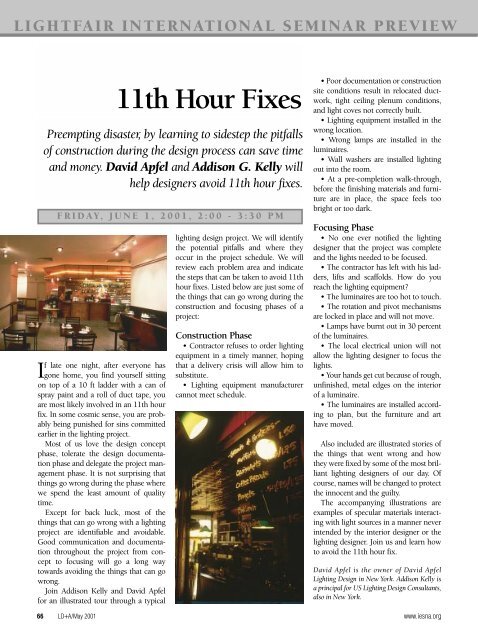Cover 1_rto4 - Illuminating Engineering Society
Cover 1_rto4 - Illuminating Engineering Society
Cover 1_rto4 - Illuminating Engineering Society
You also want an ePaper? Increase the reach of your titles
YUMPU automatically turns print PDFs into web optimized ePapers that Google loves.
LIGHTFAIR INTERNATIONAL SEMINAR PREVIEW<br />
If late one night, after everyone has<br />
gone home, you find yourself sitting<br />
on top of a 10 ft ladder with a can of<br />
spray paint and a roll of duct tape, you<br />
are most likely involved in an 11th hour<br />
fix. In some cosmic sense, you are probably<br />
being punished for sins committed<br />
earlier in the lighting project.<br />
Most of us love the design concept<br />
phase, tolerate the design documentation<br />
phase and delegate the project management<br />
phase. It is not surprising that<br />
things go wrong during the phase where<br />
we spend the least amount of quality<br />
time.<br />
Except for back luck, most of the<br />
things that can go wrong with a lighting<br />
project are identifiable and avoidable.<br />
Good communication and documentation<br />
throughout the project from concept<br />
to focusing will go a long way<br />
towards avoiding the things that can go<br />
wrong.<br />
Join Addison Kelly and David Apfel<br />
for an illustrated tour through a typical<br />
11th Hour Fixes<br />
Preempting disaster, by learning to sidestep the pitfalls<br />
of construction during the design process can save time<br />
and money. David Apfel and Addison G. Kelly will<br />
help designers avoid 11th hour fixes.<br />
FRIDAY, JUNE 1, 2001, 2:00 - 3:30 PM<br />
lighting design project. We will identify<br />
the potential pitfalls and where they<br />
occur in the project schedule. We will<br />
review each problem area and indicate<br />
the steps that can be taken to avoid 11th<br />
hour fixes. Listed below are just some of<br />
the things that can go wrong during the<br />
construction and focusing phases of a<br />
project:<br />
Construction Phase<br />
• Contractor refuses to order lighting<br />
equipment in a timely manner, hoping<br />
that a delivery crisis will allow him to<br />
substitute.<br />
• Lighting equipment manufacturer<br />
cannot meet schedule.<br />
• Poor documentation or construction<br />
site conditions result in relocated ductwork,<br />
tight ceiling plenum conditions,<br />
and light coves not correctly built.<br />
• Lighting equipment installed in the<br />
wrong location.<br />
• Wrong lamps are installed in the<br />
luminaires.<br />
• Wall washers are installed lighting<br />
out into the room.<br />
• At a pre-completion walk-through,<br />
before the finishing materials and furniture<br />
are in place, the space feels too<br />
bright or too dark.<br />
Focusing Phase<br />
• No one ever notified the lighting<br />
designer that the project was complete<br />
and the lights needed to be focused.<br />
• The contractor has left with his ladders,<br />
lifts and scaffolds. How do you<br />
reach the lighting equipment?<br />
• The luminaires are too hot to touch.<br />
• The rotation and pivot mechanisms<br />
are locked in place and will not move.<br />
• Lamps have burnt out in 30 percent<br />
of the luminaires.<br />
• The local electrical union will not<br />
allow the lighting designer to focus the<br />
lights.<br />
• Your hands get cut because of rough,<br />
unfinished, metal edges on the interior<br />
of a luminaire.<br />
• The luminaires are installed according<br />
to plan, but the furniture and art<br />
have moved.<br />
Also included are illustrated stories of<br />
the things that went wrong and how<br />
they were fixed by some of the most brilliant<br />
lighting designers of our day. Of<br />
course, names will be changed to protect<br />
the innocent and the guilty.<br />
The accompanying illustrations are<br />
examples of specular materials interacting<br />
with light sources in a manner never<br />
intended by the interior designer or the<br />
lighting designer. Join us and learn how<br />
to avoid the 11th hour fix.<br />
David Apfel is the owner of David Apfel<br />
Lighting Design in New York. Addison Kelly is<br />
a principal for US Lighting Design Consultants,<br />
also in New York.<br />
66 LD+A/May 2001 www.iesna.org

















